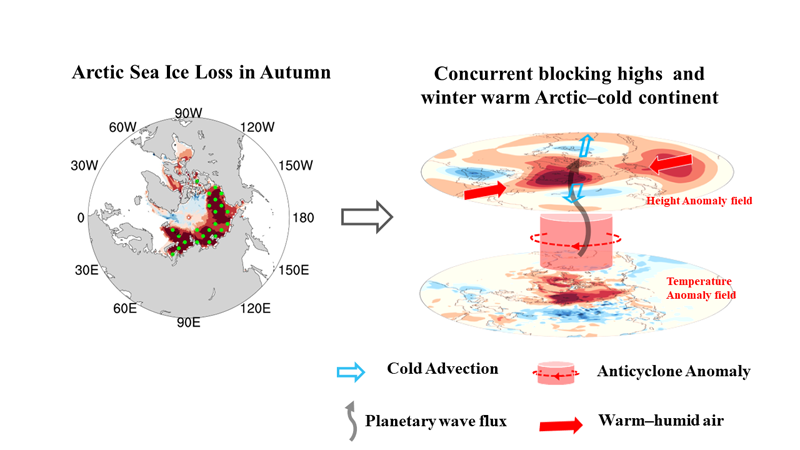State Key Laboratory of Numerical Modeling for Atmospheric Sciences and
Geophysical Fluid Dynamics (LASG)
Institute of Atmospheric Physics, Chinese Academy of Sciences

Vol.18/No.18 December 2022
The Ural and North Pacific Blockings Jointly Affect the Warm Arctic-Cold Continent
A new study published in Journal of Geophysical Research: Atmospheres led by Prof. XIAO Ziniu and Dr. ZHAO Liang from the State Key Laboratory of Numerical Modeling for Atmospheric Sciences and Geophysical Fluid Dynamics (LASG), the Institute of Atmospheric Physics (IAP) of the Chinese Academy of Sciences and their collaborators revealed that the Ural and North Pacific blocking high pressures jointly affect the WACC. Blocking high pressures is a slowly moving or quasi-stationary closed high pressure that develops on the westerly zone, causing the westerly zone to branch and hindering the movement of the weather system.

Schematic diagram of relations of enhanced high-latitude concurrent blocking highs with recent warm Arctic–cold continent pattern. (Image by ZHAO Liang)
Researchers conducted in-depth study on the relation among the blocking highs, the Arctic Oscillation and the WACC. They constructed an index of high-latitude concurrent blocking highs to characterize the phenomenon that blockings frequently occur simultaneously at high latitudes. They also examined how concurrent blocking highs and Arctic Oscillation affect the WACC on interdecadal timescales.
"We found that the WACC is much more highly correlated with the high-latitude concurrent blocking highs between the Ural blocking high and the North Pacific blocking high than the Arctic Oscillation. And in recent years, with the enhancement of blocking synergy, the WACC is also gradually enhanced." Said Dr. ZHAO Liang, the lead author of the paper.
"The increased blocking firstly induces the Arctic warming by transmitting a large amount of water vapor and heat to the Arctic region. This process causes the weakening of the circumpolar jet and the polar movement of the subtropical westerly jet, and finally results in a weak cooling in the mid-latitude continent, forming the WACC." Dr. DONG Wei from Nanjing University of Information Science and Technology, one of the corresponding authors further explained.
The study also examined the WACC with concurrent blocking highs reproduction in simulations with human activity. Experiments show that human activities may make the blocking synergy more significant.
"This indicates that it is highly necessary to pay attention to the increasing concurrent blockings in warming climate. Relevant study is expected to help improve the predictability of extreme cold events in winter." Prof. XIAO Ziniu, the corresponding author highlighted.
The research was jointly supported by the National Natural Science Foundation of China (41790471, 42075040, U1902209), the Strategic Priority Research Program of the Chinese Academy of Sciences (XDA20060501, XDA20100304) and the National Key Research and Development Program of China (2018YFA0606203; 2019YFC1510400).
References:
Zhao, L., Dong, W.*, Dong, X., Nie, S., Shen, X., & Xiao, Z*. (2022). Relations of enhanced high-latitude concurrent blockings with recent warm Arctic-cold continent patterns. Journal of Geophysical Research: Atmospheres, 127, e2021JD036117. https://doi.org/10.1029/2021JD036117.
Link:https://doi.org/10.1029/2021JD036117
Contact: DONG Wei, dw_nuist@163.com; XIAO Ziniu, xiaozn@lasg.iap.ac.cn
E-mail: lasg_newsletter@lasg.iap.ac.cn
Editors: Chuanyi Wang (wangcy@lasg.iap.ac.cn), Kangjun Chen(ckj@lasg.iap.ac.cn)